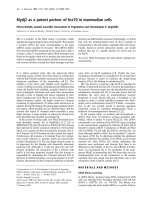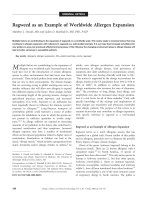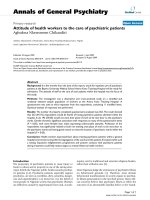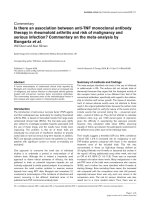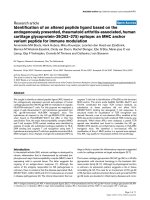Báo cáo y học: "Lepirudin as an alternative to “heparin allergy” during cardiopulmonary bypas" pot
Bạn đang xem bản rút gọn của tài liệu. Xem và tải ngay bản đầy đủ của tài liệu tại đây (365.11 KB, 5 trang )
CAS E REP O R T Open Access
Lepirudin as an alternative to “heparin allergy”
during cardiopulmonary bypass
Haralabos Parissis
Abstract
A treatment strategy of a difficult and unusual problem is presented. We are reporting a case of a patient who had
a documented allergy to heparin and required Cardiac surgery for an ASD clo sure. The anticoagulation regime
used during cardiopulmonary bypass was lepirudin based.
This report indicates that r-hirudin provides effective anticoagulation, however unless ECT is monitoring, post
operative hemorrhage is encountered. Therefore this case is unique not only because of its rarity but also by the
fact that it presents the caveats enco untered when ECT is not available.
Introduction
Traditionally in our effort to maintain optimal cardio-
pulmonary bypass during cardiac surgery, high dose
unfractionated heparin is being used ; however there are
conditions that the use of heparin is contraindicated.
Various thrombin inhibitors could theoretically being
used instead, with the favor being Hirudin and lately
bivalirudin
Hirudin
Hirudin is a potent natural direct thrombin inhibitor
that is derived from the salivary glands of the medicinal
leech, Hirudo medicinalis [1]. It is a 65-amino-acid poly-
peptide that forms a tight, irreversible 1:1 complex with
thrombin (1 molecule of hirudin binds with 1 molecule
of thrombin).
Hirudin shows both direct a nti-Xa activity as well as
activation of antithrombin III [2]. It is the most potent
and specific thrombin inhibitor known. Uunlike heparin,
it is not inactivated by Platelet Factor 4 (PF4), and also
can inhibit thrombin bound within the clot [3]. Hirudin
is now produced, by using recombinant technology
(r-hirudin). Two r-hirudins have been commercially pro-
duced (lepirudin and desirudin); however, lepirudin has
been more extensively studied and is the focus of this
review.
Lepirudin is an anti-thrombotic recombinant DNA
form of hirudin derived from yeast cells. Each vial of
Refludan contains 50 mg of lepi rudin. It is normally used
in adult patients requiring anticoagulation who have
Heparin Induced Thrombocytopenia (HIT) type II [4].
Two binding sites are pres ent on the thrombin mole-
cule: the active site that catalyzes the majority of the
functions of thrombin, and t he -brinogen-binding site
that mediates binding of thrombin to -brinogen.
Hirudin (lepirudin) binds irreversibly to both the
active site and the -brinogen-binding site. Therefore
lepirudin is a bivalent direct thrombin inhibitor. The
amino-terminal domain binds to the active site of the
thrombin molecule and the carboxyterminal domain
interacts with the -brinogen-binding site.
The drug distribution follows a two -compartment
model with distribution essentially confined to extracel-
lular fluids. There is no known antidote. Clearance from
the body is mainly via the kidneys and therefore patients
must have normal kidney function if they are to receive
this drug.
Themostcommonsideeffectofthedrugusedin
non-surgical cases is bleeding. The extent of the bleed-
ing following Hirudin administration ranges from mild
bruising to severe bleeding (incidence >10%) which can
be fatal (incidence 1%). Other rare complications
include allergic skin reaction s, anaphylactic reactions
and injection site pain [5].
Wearereportingararecaseofapatientwhohadan
allergy to heparin and required Cardiac surgery for a
closure of a large atrial septal defect.
To the best of my knowledge there is only one similar
report in the literature that discusses the problem of
Correspondence:
Cardiothoracic Dept, Royal Victoria Hospital, Grosvernor Rd, Belfast, BT12 6BA,
Northern Ireland
Parissis Journal of Cardiothoracic Surgery 2011, 6:44
/>© 2011 Parissis; licensee BioMed Central Ltd. This is an Open Access article distributed under the terms of t he Creative Commons
Attribution License (http://creativecommons.o rg/licenses/by/2.0), which p ermits unrestricted use, distribution, and reproductio n in
any medium, provided the original work is properly cited.
allergy to h eparin in a patient requiring CPB [6]. More-
over this case has a didactic character, because it pre-
sents the caveats encountered when ECT is not
available.
Case report
A 30 year old female (47 Kgr) was admitted to the hos-
pital with constitutional symptoms and a large ejection
murmur. A large 3 by 4.5 cm secundum Atrial Septal
Defect (ASD) was diagnosed using Trans-Thoracic
Echocardiogram. There was also a history of transient
neurological deficit that was thought to be the result of
paradoxical emboli across the ASD.
Further examination revealed a dilated right atrium
and moderate pulmonary hypert ension. The patient was
started o n a prophylactic Tinzaparin and subsequently
developed generalized itching, flushing, bronchospasm, a
widespread urticarial red rash and hypotension. Parent-
eral H1 antagonists, and epinephrine was administered
promptly and the patient was resuscitated with fluids
and intravenous steroids, systemically. The symptoms
fully resolved in 12 hours. Unfortunately, skin testing is
equivocal in diagnosing heparin allergy; Furthermore
ELISA screening for Heparin/PF4 antibodies is also not
consistent test and “ systemic heparin testing” was
decided against, due to the previous generalized reaction
and the subsequently anticipated dangers involved.
The patient was commenced on warfarin, in view o f
the history of TIAs. Cardiac angiography revealed nor-
mal c oronary arteries and confirmed the presence of a
large ASD with left to right shunt and was referred to
the Cardiac Surgical service for repair of the A SD. Due
to the high likelihood of allergy to heparin and in the
absence of standardized tests for heparin hypersensitiv-
ity, the options available were to either desensitize the
patient to heparin or to use an alternative anticoagulant.
Following discussions with haematologists and immu-
nologist, it was decided to utiliz e an al ternative anticoa-
gulant during the repair procedure i.e. Lepirudin, trade
name Refludan (Schering AG Germany).
During the procedure, a standard non-heparin coated
CPB circuit was set up in advance (Terumo Capiox
hard-shell venous reservoir and oxygenator). This was
primed with as usual with 1200 mls of Hartmann’s solu-
tion, 50 mmol Sodium Bicarbonate and 25 g mannitol.
The 5000 I.U. of heparin normally added to the prime
was substituted with 0.5 mg/kg (25 mg) of Lepirudin.
Pre-operative aPTT/INR and ACT tests were performed
and normal results received (see table 1 be low). Pre-op
Hb was 12.0 g/dl.
Prior to aortic cannulation, a loading dose of 0.5 mg/kg
(25 mg) Lepirudin via the central line was administered.
Following a 10 minute interval in order to allow the drug
to circulate, th e aPT T/INR and ACT tests were repeated.
The target values of aPTT >200 sec, INR >2.5 and ACT
> 400 sec were achieved before cannulation and initiation
ofCPB.RepeattestingofbothAPTTandACTwasper-
formed at 15 minute intervals until CPB was complete.
A maintenance infusion dose of 0.15 mg/kg/hour was
running during CPB, until 10 minutes before weaning
from CPB. The operation involved 40 minutes cross
-clamp time and 67 m inutes total bypass time. As it is
notpossibletoreversetheactivityofLepirudin,great
care was taken to ensure excellent haemostasis through-
out the case. Normal coagulation status is only achieved
once the Lepirudin has been comple tely cleared by the
kidneys. Immediately following discontinuation of CPB,
any Lepir udin i nfusions running were stopped. The to tal
peri-operatively blood loss was 370 mls. The immediate
postoperative Hb was 7.0 g/dl, the drop being mainly
attributed to hemodilution with pump prime. The final
readings for coagulati on tests at completion of CPB were
APTT 111 sec, INR 3.0 and ACT 478 sec.
Blood loss increased following patient transfer to the
ITU as shown in Table 1. This required aggressive man-
agement and the transfusion of multiple blood products
over the next 12 hours. These products included 10 units
red cell concentrate (RCC), 6 units fresh frozen plasma
(FFP), and 2 units of pooled platelets. Four hours post-op
on the advise of the consultant hematologist a fibrinogen
assay was performed. The result (0.98 g/l) showed the
fibrinogen levels to be low (normal range 1.7- 4.1 g/l).
Four units of cryoprecipitate were subsequently trans-
fused. This successfully returned fibrinogen levels to
normal as repeat fibrinogen assays, performed 2 hours
later, demonstrated (result 2.0 g/l). Blood drainage was
markedly reduced following the cryoprecipitate transfu-
sion. Chest drainage in the first 24 hrs post-operatively
was in excess of 5 litres. The chest drains were removed
and the patient returned to the ward on the 4
th
post-
operative day.
Discussion
Immune-mediated allergic r eactions to heparin have
been encountered more often recently, due to the abun-
dance use of this substance for prophylaxis or treatment
of Coronary syndromes.
Types of immune-mediated reactions to heparin
Immediate type I hypersensitivity reacti on, (experienced
by the patient of the current case report), is a IgE
mediated hypersensitivity that can lead to urticarial rash,
asthma and anaphylaxis.
Heparin-induced thrombocytopenia type II, is an
immune-mediated condition that occurs when predomi-
nantly IgG antibodies are produced, against platelet
Parissis Journal of Cardiothoracic Surgery 2011, 6:44
/>Page 2 of 5
factor 4 (PF4)-heparin complexes. The binding of
heparin to P F4 results i n the expression of several anti-
genic sites, which trigger the production of IgG [7].
Subsequently, the large complex of heparin, PF4, and
IgG results in platelet activation, platelet destruction,
and release of prothrombotic microparti cles from plate-
lets and finally disturbance of e ndothelial cells [8]. The
“end result” leads to a paradoxic prothrombot ic state
(low platelet count, arterial and venous thrombosis).
This is what is been considered as the “white clot” syn-
drome due to platelet-to-platelet adhesions without ery-
throcytes being trapped in the clot.
It has been reported that HIT II is identified in 1% of
cases in patients who undergo open heart surgery [9].
This case was u nusual in that it involved a patient
with heparin type I allergy. A desensitization protocol
has been advocated for patients with heparin allergy, but
its efficacy is still anecdotal. Alternative anticoagulation
strategies when CPB is necessary have been predomi-
nantly suggested in patients with t ype II reactions.
Lepirudin is a potent antithrombin, very effective in
inhibiting both free and clot-bound thrombin [10].
There are numerous reports o f Lepirudin been used as
an alternative anticoagulant to Heparin during CPB in
patients with HIT [11,12].
The difficulties with the use of lepirudin for CPB are
twofold. First, the suitable laboratory tests for assessing its
effect are frequent unavailability in standard hospi tal
laboratories. Furthermore, the unavailability of a reversing
agent greatly increases the potential for peri-operative
bleeding. These difficulties can be addressed with the pro-
vision of adequate tests, (aPTT/INR) or ideally the ecarin
clotting time (ECT) test and meticulous peri-operative
haemostasis.
Lepirudin regime for CPB
The use of lepirudin, to systemically anticoagulate a
patient during CPB, instead of heparin has important
implications. It renders the standard ACT testing, inade-
quate. Moreover, lepirudin cannot be reversed, as with
the heparin-protamine comb ination, therefore it ’ suse
may result in greater peri-operative bleeding.
A l ow dose of lepirudin is usually recommended for
the treatment of HIT and higher doses are required for
patients with HIT and established thrombosis or
patients requiring CPB procedure [4].
Table 1 ACT, APTT and INR values Peri and Post-operatively; Also blood loss, Hb concentration and blood product use
peri-operatively, is reported
Time (Hours) ACT (sec) APTT (sec) INR Blood loss (ml) Hg (mg/dl) Blood products
Operating Theatre
10:15 am ( Pre-op) 132 29.4 1.3 140 12.0
11:00 (post-lepirudin) >1300 >200 10.0
11:25 (pre-CPB) >1500 120 1.9
11:43 (CPB+5 mins) >1000 >250 >10
12:00 (+20 min) >1000 >250 >10
12:15 pm (+35 min) >1000 >250 >10
12:30 (+50 min) 436 130 6.6
12:45 ( off CPB) 478 111 3.0
13:15 (+30 min post-CPB) 476 73 1.9 230 7.0 NONE
ITU
14:10 54 1.5 140 8.9
15:00 38 1.3 40 7.7
16:15 47 1.7 30 8.9 RCC:2, FFPs:2
17:00 51 1.5 40 7.5 RCC:2
18:50 40 1.3 3000 6.7 PLTs:2
FFPs:2
20:50 44 1.3 1800 5.9 RCC:6
PLTs:2
CryoP:4
FFPs:2
Day 1
16:00 34 1.2 200 8.9 NONE
18:00 38 1.3 40 9.0
Note that while the total theatre blood loss was 370 mls, the total ICU blood loss was 5300 mls.
Parissis Journal of Cardiothoracic Surgery 2011, 6:44
/>Page 3 of 5
The dosage regime of the drug for CPB used for this
case was a 0.5 mg/kg intravenous (IV) bolus with
0.5 mg/kg added to the pump prime and a maintenance
dose of 0.15 mg/kg/hr given by infusion. Variations in
dosage regimes for Lepirudin use during CPB have been
described by different authors [4,12,13]. The most
common dosage regime is 0.25-0.4 m g/kg I.V bolus,
0.20 mg/kg in the pump prime and 0.15 mg/kg/hr main-
tenance dose given by infusion when the monitoring
tests fall below acceptable limits [13].
There is no direct correlation between Lepirudin levels
and ACT values, however different anticoagulation mon-
itoring methods have been tried where Lepirudin is in
use; aPTT should be maintained in excess of 200 sec &
the INR should be maintained between 2- 2.5.
The ACT does not test for factor-Xa blockade and
therefore there is only a small but incremental chan ge
in the ACT with hirudin. The ecarin clotting time
(ECT) is the most suitable test for following dosing of
lepirudin. Ecarin is derived from the venom of the snake
Echis carin atum. Ecarin converts prothrombin to meizo-
thrombin, which has moderate clotting activity. Meizo-
thrombin binds avidly to direct thrombin inhibitors
such as lepirudin. Therefore, when all of the lepirudin
has been neutralized by meizothrombin in t he blood
sample, clotting will be initiated. There is a direct rela-
tionship between therapeutic levels of lepirudin and pro-
longation of ECT during CPB. There are however, a
great number of questions needing to be answered. Do
temperature, hemodilution, severe platelet function
abnormalities, the usage of anti pla telet agents such as
abciximab or extremely low fibrinogen concentrations
affect the ECT? Lastly, relatively normal serum levels of
pro-thrombin and -brinogen are required for accurate
ECT results. Degradation and elimination of lep irudin
occur primarily i n the kidneys; the lepirudin plasma
elimination half- life is approximately 80 minutes in
normal subjects, however plasma half-life may be greater
than 120 hours in the presence of renal impairment.
Therefore l ower doses of lepirudin are required under
such conditions.
There are no antidote agents for the anticoagulant
effect of lepirudin. Koster et al [12] have published o n
the use of ultra-ltration to enhance the elimination of
lepirudin during CPB; they concluded that Plasmapher-
esis-lter sys tems were more effective in removing lepiru-
din than hemo-lter systems (60%-70% v 15%-40%
reductioninplasmaconcentrationsoflepirudin,
respectively).
Broadly speaking, inadequate anticoagulation is occur
at lepirudin levels less than 1.8 to 2.0 μg/mL. In con-
trary with lepirudin concentrations greater than 4.5 μg/
mL the incidence of high postoperative blood loss
becomes significant. The recommended target level of
lepirudin during CPB, based on various studies [13-15]
is 3.5 to 4.5 μg/mL.
The initial short half-life of the drug (1 0 min) and the
leaking to the extravascular space makes e stimation of
the correct dosage difficult. The post-lepirudin INR in
the above case was initially excessive (10.0). It fell
rapidly to 1.9 i.e. to within the recommended levels
(2.0-2.5) before CPB was commenced. On initiation of
CPB the INR again rose, presumably due to the pump-
prime drug dose. This pump-prime lepirudin dose
(0.5 mg/kg) was the upp er limit of that recommended
[16]. The resulting high INR results (>10) that were
maintained for approximately one hour of CPB m ay
indicate that the pump -prime dose of lepirudin could
be reduced in future cases. The maintenance infusion
should be adjusted when INR results exceed the target
range during CPB. The INR fell to within this recom-
mended rang e by 30 mins post-CPB and remained low
throughout the entire post-op period. The later post-op
bleeding may be a “ heparin- rebound “ (lepirudin
rebound in this case) type effect of the extravascular
space Lepirudin re-entering the vascular system post-
operatively. However one would expect to see a simulta-
neous increase in the INR if this were the case. This did
not occur. The severe post -operative coagulopathy
experienced in this case, (also reported b y other groups
[17,18]), requiring the transfusion of a large number of
blood pro ducts, highlights the difficulties of using Lepir-
udin as a systemic anticoagulant for CPB, especially
when ECT is not available. The prompt transfusion of
appropriate blood products in adequate amounts may
also be necessary in the post-operativ e period. Fibrino-
gen assaying and cryoprecipitate transfusions should be
used where indicated.
Lepirudin might well be recommended to be available
in all centers that perform cardiac surgery. Lepirudin,
however, is not the ultimate anticoagulant for CPB to
replace unfractionated heparin. It requires renal clear-
ance, increases bleeding diathesis and it is also antigenic.
It is almost the same size m olecule as both protamine
and apr otinin. Both of thes e agents are known for their
antigenicity. As per Song et al [19] lepirudin, being a
foreign amino acid, will produce its own incidence of
allergic reactions.
Bivalirudin could have possibly been alternati ve ther-
apy especially foll owing increasing evidence on its safety
and efficacy [20]. Howev er the current evid ence regard-
ing the proper ties of bivalirudin where not known at the
time of the reported case. Retrospectively, taking into
account the increased possibility of anaphylaxis after
exposure to lepirudin, the unavailability of the ecarin
clotting time (ECT) test in some European inst itutions
[21], and the difficulties we faced in terms of monitoring
anticoagulat ion and postoperative excessive bleeding we
Parissis Journal of Cardiothoracic Surgery 2011, 6:44
/>Page 4 of 5
would consider bivalirudin rather than lepirudin, in a
similar case in the future.
In summary, lepirudin provides effective CPB antico a-
gulation but induces a higher postoperative blood loss
than heparin, especially when ECT test is unavailable.
Lepirudin should be restricted to patients undergoing
CPB who cannot be exposed to heparin. For future such
cases we would endeavor to use the ECT te st, in con-
junction with aPTT/INR testing for optimal monitor
blood lepirudin levels peri-operatively. The drug dose,
particularly in the pump prime, should be reduced to
the lower recommended level of 0.20 mg/kg. The lepiru-
dininfusionshouldbeadjustedtomaintaintheINR
within the recommended limits. The use a cell-saver
post-operatively, in order to process residual pump
blood and shed chest-drain blood, should also be con-
sidered. This would reduce the post-operative lepirudin
levels in transfused blood.
Finally, being adequately prepared for future cardiac
surgical patients requiring systemic alternative to
heparin anticoagulation, is particularly important , as the
incidence of HIT in these patients is expected to
increase. This maybe due to the increasing number of
hospitalized patients in cardiac wards, awaiting surgical
intervention, many o f whom would be on Heparin ther-
apy with an increased risk of developing HIT
Authors’ contributions
HP conceived the study and wrote the MS.
Authors’ statement
All authors read and approved the final manuscript.
Competing interests
The author declares that they have no competing interests.
Received: 5 November 2010 Accepted: 8 April 2011
Published: 8 April 2011
References
1. Markwardt F: Hirudin: the promising antithrombotic. Cardiovasc Drug Rev
1992, 10:211-232.
2. Gardell SJ, Sanderson PE: Novel anticoagulants based on direct inhibition
of thrombin and factor Xa. Coron Artery Dis 1998, 9:75-8 1.
3. Weitz JI, Huboda M, Massel D, Marganore J, Hirsh J: Clot-bound thrombin
is protected from inhibition by heparin-antithrombin III but is
susceptible to inactivation by antithrombin III-independent inhibitors.
J Clin Invest 1990, 86:385-391.
4. Greinacher A, Völpel H, Janssens U, Hach-Wunderle V, Kemkes-Matthes B,
Eichler P, H G: Mueller-Velten and B. Pötzsch. Recombinant Hirudin
(Lepirudin) Provides Safe and Effective Anticoagulation in Patients With
Heparin-Induced Thrombocytopenia: A Prospective Study. Circulation
1999, 99:73-80.
5. Greinacher A, Lubenow N: Recombinant hirudin in clinical practice: Focus
on lepirudin. Circulation 2001, 103:1479-1484.
6. Pappalardo F, Franco A, Crescenzi G, Poli A, Zangrillo A, Koster A:
Successful use of bivalirudin for cardiopulmonary bypass in a patient
with heparin allergy. Perfusion 2007, 22:67-69.
7. Warkentin TE: Heparin-induced thrombocytopenia: pathogenesis and
management. Br J Haematol 2003, 121:535-555.
8. Warkentin TE, Hayward CPM, Boshkov LK, Santos AV, Sheppard JI, Bode AP,
Kelton JG: Sera from patients heparin-induced thrombocy- topenia
generate platelet-derived microparticles with procoagulant activity: an
explanation for the thrombotic complications of heparin- induced
thrombocytopenia. Blood 1994, 84:3691-3699.
9. Walls JT, Curtis JJ, Silver D, Boley TM: Heparin-induced thrombocytopenia
in patients who undergo open heart surgery. Surgery 1990, 108:686-693.
10. Weitz JI, Leslie B, Hudoba M: Thrombin binds to soluble -brin degradation
products where it is prothrombosed from inhibition by heparin-
antithrombin but susceptible to inactivation by antithrombin-
independent inhibitors. Circulation 1998, 97:544-552.
11. Riess FC: Anticoagulation management and cardiac surgery in patients
with heparin-induced thrombocytopenia. Semin Thorac Cardiovasc Surg.
Spring 2005, 17(1) :85-96.
12. Koster A, Hansen R, Kuppe H, Hetzer R, G J: Crystal, F Mertzlufft.
Recombinant Hirudin as an Alternative for Anticoagulation During
Cardiopulmonary Bypass in Patients With Heparin-Induced
Thrombocytopenia Type II: A 1-Year Experience in 57 Patients. Journal of
Cardiothoracic and Vascular Anesthesia 2000, 243-248, Vo114, No 3 (June).
13. Riess FC, Poetzsch B, Madlener K, Cramer E, Doll KN, Doll S, Lorke DE,
Kormann J, Mueller-Berghaus G: Recombinant hirudin for
cardiopulmonary bypass anticoagulation: a randomized, prospective,
and heparin-controlled pilot study. Thorac Cardiovasc Surg 2007,
55(4):233-8.
14. Greinacher A, Vö1pel H, Janssens U, et al: Recombinant hirudin (lepirudin)
provides safe and effective anticoagulation in patients with heparin-
induced thrombocytopenia. A prospective study. Circulation 1999,
99:73-80.
15. Greinacher A, Lepirudin : a bivalent direct thrombin inhibitor for
anticoagulation therapy. Expert Rev Cardiovasc Ther 2004, 2(3):339-57.
16. Murphy GS, Marymont JH: Alternative anticoagulation management
strategies for the patient with heparin-induced thrombocytopenia
undergoing cardiac surgery. J Cardiothorac Vasc Anesth 2007, 21(1):113-26,
Epub 2006 Oct 24.
17. Riess FC, Pötzsch B, Bader R, et al: A case report on the use of
recombinant hirudin as an anticoagulant for car- diopulmonary bypass
in open heart surgery. Eur J Cardiothorac Surg 1996, 10:386-8.
18. Longrois D, de Maistre E, Bischoff N, Dopff C, Meistelman C, Angioï M,
Lecompte T: Recombinant hirudin anticoagulation for aortic valve
replacement in heparin-induced thrombocytopenia. Can J Anaesth 2000,
47(3):255-60.
19. Song X, Huhle G, Wang L, et al: Generation of anti-himdin antibodies in
heparin-induced thrombocytopenia patients treated with r-hirudin.
Circulation 1999, 5 :1528-1532.
20. Dyke CM, Smedira NG, Koster A, Aronson S, McCarthy HL, Kirshner R,
Lincoff AM, Spiess BD: A comparison of bivalirudin to heparin with
protamine reversal in patients undergoing cardiac surgery with
cardiopulmonary bypass: the EVOLUTION-ON study. J Thorac Cardiovasc
Surg 2006, 131(3):533-9.
21. Greinacher A, Lubenow N, Eichler P: Anaphylactic and anaphylactoid
reactions associated with lepirudin in patients with heparin-induced
thrombocytopenia. Circulation 2003, 108:2062-65.
doi:10.1186/1749-8090-6-44
Cite this article as: Parissis: Lepirudin as an alternative to “heparin
allergy” during cardiopulmonary bypass. Journal of Cardiothoracic Surgery
2011 6:44.
Parissis Journal of Cardiothoracic Surgery 2011, 6:44
/>Page 5 of 5

